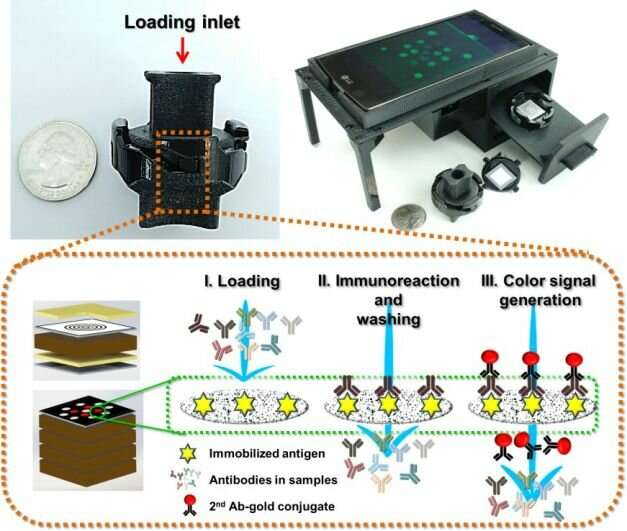Paper-based multi target diagnostic test. Credit: UCLA Engineering Institute for Technology Advancement
Diagnosing a disease is a crucial first step in providing care. However, many regions around the world lack the centralized infrastructure and trained personnel to perform these tests. This leads to the need for low-cost test alternatives, which can be administered at the point of care. To meet this demand, easy-to-read diagnostic tests constructed from paper have been developed and implemented to combat a number of diseases across the world creating nearly a $6 billion market. These paper-based tests, commonly referred to as Lateral Flow Assays, detect the presence of specific molecules in a sample such as blood or urine by inducing a color change along a 'test line' contained on the paper strip, functioning similarly to the well-known pregnancy tests.
Although such paper-based tests have been developed for detecting a number of disease causing agents such as malaria parasites, HIV, and Zika virus, they cannot reliably detect multiple types of molecules simultaneously, limiting their application to a broader range of diagnostic needs.
Researchers at the UCLA Samueli School of Engineering have created a new paper-based sensor which overcomes these limitations, opening the door for new diagnostic applications. The results from the evaluation of this new inexpensive paper-based sensor were published in Lab on a Chip, a journal of the Royal Society of Chemistry (UK).
Aydogan Ozcan, Chancellor's Professor of Electrical & Computer Engineering and the associate director of the California NanoSystems Institute at UCLA led the research in collaboration with Professor Dino Di Carlo of the UCLA Bioengineering Department, Professor Omai Garner, the associate director of UCLA Clinical Microbiology Lab, and Dr. Hyou-Arm Joung, a senior research associate at UCLA Electrical & Computer Engineering Department.
This new paper-based sensor employs a specially designed 'sensing membrane' that contains dozens of individual reaction spots, each of which can detect a different disease-specific molecule. This operation is made possible by the implementation of a vertical stack of paper and wax-printed layers, carefully engineered to ensure that the patient sample, in this case processed blood, uniformly interacts with each reaction spot on the 1 cm x 1 cm paper-based sensing membrane. Therefore, this multi-detection design can perform much more complex tests needed for e.g., cancer, cardiovascular disease, or Lyme disease, among others, while still employing $0.30 worth of paper materials, along with simple operating steps which can be completed in under 20 minutes with minimal training of the user.
Importantly, the UCLA team has also developed a low-cost cellphone attachment, which is used to analyze the paper-based tests, rapidly reporting the results back to the user through a mobile app.
"This new multiplexed testing platform is promising to propel paper-based diagnostics into new and exciting territories as it can be adapted for a number of different diagnostic targets," said Dr. Ozcan. "In fact, we have already found a promising opportunity for Lyme Disease diagnosis with our multiplexed paper-based sensor."
The researchers tested the performance of the new paper-based sensor on human blood-serum samples confirmed to be Lyme-positive, demonstrating the simultaneous detection of three common Lyme-specific antibodies, showing promise as a future diagnostic tool which could replace the costly equipment and trained technicians currently needed to run the traditional laboratory tests. With Lyme disease becoming more prevalent in the United States, the recent invention by Ozcan and his colleagues is an important step towards addressing this growing threat to public health.
More information: Hyou-Arm Joung et al. Paper-based multiplexed vertical flow assay for point-of-care testing, Lab on a Chip (2019). DOI: 10.1039/C9LC00011A
Journal information: Lab on a Chip
























